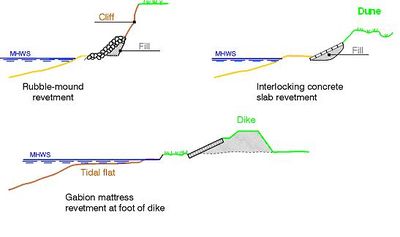Difference between revisions of "Revetments"
m (→See also) |
(→Exposed revetments) |
||
| Line 9: | Line 9: | ||
However, revetments can also consist of different kinds of concrete slabs, some of them permeable and interlocking. In this way their functionality is increased in terms of absorption and strength. An example of a permeable and interlocking concrete slap is the so-called Flex Slap. | However, revetments can also consist of different kinds of concrete slabs, some of them permeable and interlocking. In this way their functionality is increased in terms of absorption and strength. An example of a permeable and interlocking concrete slap is the so-called Flex Slap. | ||
| − | Net mesh stone-filled mattresses, such as | + | Net mesh stone-filled mattresses, such as [[gabions]], are also used; however, they are only recommended for use at fairly protected locations. |
Revetments can also consist of sand-filled geotextile fabric bags, mattresses and tubes. Such structures must be protected against UV-light to avoid weathering of the fabric. Sand-bagging is often used as emergency protection. Geotextile fabric revetments are fragile against mechanical impact and vandalism, and their appearance is not natural. | Revetments can also consist of sand-filled geotextile fabric bags, mattresses and tubes. Such structures must be protected against UV-light to avoid weathering of the fabric. Sand-bagging is often used as emergency protection. Geotextile fabric revetments are fragile against mechanical impact and vandalism, and their appearance is not natural. | ||
[[Image:Revetments.jpg|400px|thumb|center|Fig. 1. Examples of revetments.]] | [[Image:Revetments.jpg|400px|thumb|center|Fig. 1. Examples of revetments.]] | ||
| − | |||
===Buried revetments=== | ===Buried revetments=== | ||
Revision as of 17:27, 30 November 2007
The following article discusses the fixing of the coastline by revetments.
Contents
Method
Revetments can be an exposed structure as well as a buried structure.
Exposed revetments
Revetments are always made as sloping structures and are very often constructed as permeable structures using natural stones or concrete blocks, thereby enhancing wave energy absorption and minimising reflection and wave run-up.
However, revetments can also consist of different kinds of concrete slabs, some of them permeable and interlocking. In this way their functionality is increased in terms of absorption and strength. An example of a permeable and interlocking concrete slap is the so-called Flex Slap.
Net mesh stone-filled mattresses, such as gabions, are also used; however, they are only recommended for use at fairly protected locations.
Revetments can also consist of sand-filled geotextile fabric bags, mattresses and tubes. Such structures must be protected against UV-light to avoid weathering of the fabric. Sand-bagging is often used as emergency protection. Geotextile fabric revetments are fragile against mechanical impact and vandalism, and their appearance is not natural.
Buried revetments

A buried revetment can be constructed as part of a soft protection, e.g. as a hard emergency protection built into a strengthened dune which acts as shore protection and/or sea defence.
Functional characteristics
All types of revetments have the inherent function of beach degradation as they are used at locations where the coast is exposed to erosion. A revetment will fix the location of the coastline, but it will not arrest the ongoing erosion in the coastal profile, and the beach in front of the revetment will gradually disappear. However, as a revetment is often made as a permeable, sloping structure, it will normally not accelerate the erosion, as did seawalls; on the contrary, rubble revetments are often used as reinforcement for seawalls which have been exposed due to the disappearance of the beach. Such reinforcement protects the foot of the seawall and minimises the reflection.
A revetment, like a seawall, will decrease the release of sediments from the section it protects, for which reason it will have a negative impact on the sediment budget along adjacent shorelines.
Applicability
A revetment is a passive structure, which protects against erosion caused by wave action, storm surge and currents. The main difference in the function of a seawall and a revetment is that a seawall protects against erosion and flooding, whereas a revetment only protects against erosion. A revetment is thus a passive coastal protection measure and is used at locations exposed to erosion or as a supplement to seawalls or dikes at locations exposed to both erosion and flooding. Revetments are used on all types of coasts, however mainly types 1 - 4.
Rubble revetments and similar structures have a permeable and fairly steep slope; normally a 1:2 slope is used. This slope is suitable neither for recreational use nor for the landing or hauling of small fishing boats. Consequently, this kind of structure should not be used at locations, where the beach is used for recreation or fishing activities. For such locations, other types of protection measures must be considered, but if a revetment is required, a more gently sloping structure with a smooth surface is recommended.
References
- ↑ Danish Coastal Authority, 1998. "Menneske, Hav, Kyst og Sand". (in Danish), (Man, Sea Coast and Sand in English). Kystinspektoratet 1973-1998.
See also
Further reading
- Mangor, Karsten. 2004. “Shoreline Management Guidelines”. DHI Water and Environment, 294pg.
Please note that others may also have edited the contents of this article.
|
